A New Zn(II) Azido Complex of L-Arginine: X-ray Crystal Structure, Hirshfeld, and AIM Studies
Abstract
1. Introduction
2. Materials and Methods
2.1. Materials and Physical Measurements
2.2. Synthesis of [Zn(N3)(Arg)2](N3)·3H2O Complex
2.3. Crystal Structure Determination
2.4. Computational Details
3. Results and Discussion
3.1. Synthesis and Characterizations
3.2. X-ray Description
3.3. Molecular Packing Analysis
3.4. AIM Studies
4. Conclusions
Supplementary Materials
Author Contributions
Funding
Data Availability Statement
Acknowledgments
Conflicts of Interest
References
- Kitagawa, S.; Kitaura, R.; Noro, S.I. Functional porous coordination polymers. Angew. Chem. Int. Ed. 2004, 43, 2334–2375. [Google Scholar] [CrossRef]
- Beyazit, N.; Çakmak, D.; Demetgül, C. Chromone-based schiff base metal complexes as catalysts for catechol oxidation: Synthesis, kinetics and electrochemical studies. Tetrahedron 2017, 73, 2774–2779. [Google Scholar] [CrossRef]
- Li, X.-Y.; Chen, L.; Gao, L.; Zhang, Y.; Akogun, S.F.; Dong, W.-K. Syntheses, crystal structures and catalytic activities of two solvent-induced homotrinuclear Co(II) complexes with a naphthalenediol-based bis(salamo)-type tetraoxime ligand. RSC Adv. 2017, 7, 35905–35916. [Google Scholar] [CrossRef]
- Swiegers, G.F.; Malefetse, T.J. New self-assembled structural motifs in coordination chemistry. Chem. Rev. 2000, 100, 3483–3538. [Google Scholar] [CrossRef] [PubMed]
- Soliman, S.M.; Elsilk, S.E.; El-Faham, A. Synthesis, structure and biological activity of zinc(II) pincer complexes with 2,4-bis(3,5-dimethyl-1H-pyrazol-1-yl)-6-methoxy-1,3,5-triazine. Inorg. Chim. Acta 2020, 508, 119627. [Google Scholar] [CrossRef]
- Chai, L.-Q.; Hu, Q.; Zhang, K.-Y.; Zhou, L.; Huang, J.-J. Synthesis, structural characterization, spectroscopic, and DFT studies of two penta-coordinated zinc(II) complexes containing quinazoline and 1,10-phenanthroline as mixed ligands. J. Lumin. 2018, 203, 234–246. [Google Scholar] [CrossRef]
- Ma, S.; Zhou, H.-C. A metal-organic framework with entatic metal centers exhibiting high gas adsorption affinity. J. Am. Chem. Soc. 2006, 128, 11734–11735. [Google Scholar] [CrossRef]
- Chae, H.K.; Kim, J.; Friedrichs, O.D.; O’Keeffe, M.; Yaghi, O.M. Design of frameworks with mixed triangular and octahedral building blocks exemplified by the structure of [Zn4O(TCA)2] having the pyrite topology. Angew. Chem. 2003, 115, 4037–4039. [Google Scholar] [CrossRef]
- Kepert, C.J.; Rosseinsky, M.J. Zeolite-like crystal structure of an empty microporous molecular framework. Chem. Commun. 1999, 375–376. [Google Scholar] [CrossRef]
- Yousri, A.; El-Faham, A.; Haukka, M.; Ayoup, M.S.; Ismail, M.M.; Menofy, N.G.E.; Soliman, S.M.; Öhrström, L.; Barakat, A.; Abu-Youssef, M.A. A novel Na(I) coordination complex with s-triazine pincer ligand: Synthesis, X-ray structure, Hirshfeld analysis, and antimicrobial activity. Crystals 2023, 13, 890. [Google Scholar] [CrossRef]
- Yousri, A.; Haukka, M.; Abu-Youssef, M.A.; Ayoup, M.S.; Ismail, M.M.; El Menofy, N.; Soliman, S.M.; Barakat, A.; Noa, F.M.A.; Öhrström, L.R. Synthesis, structure diversity, and antimicrobial studies of Ag(I) complexes with quinoline-type ligands. CrystEngComm 2023, 25, 3922–3930. [Google Scholar] [CrossRef]
- Zhou, H.-P.; Gan, X.-P.; Li, X.-L.; Liu, Z.-D.; Geng, W.-Q.; Zhou, F.-X.; Ke, W.-Z.; Wang, P.; Kong, L.; Hao, F.-Y. Anion-induced assembly of five-coordinated mercury(II) complexes and density functional theory calculations to study bond dissociation energies of long Hg−N bonds. Cryst. Growth Des. 2010, 10, 1767–1776. [Google Scholar] [CrossRef]
- Gu, J.-Z.; Liang, X.-X.; Cui, Y.-H.; Wu, J.; Kirillov, A.M. Exploring 4-(3-carboxyphenyl) picolinic acid as a semirigid building block for the hydrothermal self-assembly of diverse metal–organic and supramolecular networks. CrystEngComm 2017, 19, 117–128. [Google Scholar] [CrossRef]
- Dahlous, K.A.; Soliman, S.M.; El-Faham, A.; Massoud, R.A. Synthesis and X-ray structure combined with Hirshfeld and aim studies on a new trinuclear Zn(II)-azido complex with s-triazine pincer ligand. Crystals 2022, 12, 1786. [Google Scholar] [CrossRef]
- Wu, H.; Zhang, Y.; Chen, C.; Zhang, J.; Bai, Y.; Shi, F.; Wang, X. DNA-binding studies and antioxidant activities of two-, three- and four-coordinate silver(I) complexes containing bis(2-benzimidazolyl) aniline derivatives. New J. Chem. 2014, 38, 3688–3698. [Google Scholar] [CrossRef]
- Wu, H.; Zhang, J.; Chen, C.; Zhang, H.; Peng, H.; Wang, F.; Yang, Z. Synthesis, crystal structure, and DNA-binding studies of different coordinate binuclear silver(I) complexes with benzimidazole open-chain ether ligands. New J. Chem. 2015, 39, 7172–7181. [Google Scholar] [CrossRef]
- Zhao, K.; Qu, Y.; Wu, Y.; Wang, C.; Shen, K.; Li, C.; Wu, H. Synthesis, structures and properties of copper(II) and zinc(II) complexes with 1,2-bis(benzimidazol-2-yl) ethane ligands. Transit. Met. Chem. 2019, 44, 713–720. [Google Scholar] [CrossRef]
- Dudev, T.; Lim, C. Tetrahedral vs. octahedral zinc complexes with ligands of biological interest: A DFT/CDM study. J. Am. Chem. Soc. 2000, 122, 11146–11153. [Google Scholar] [CrossRef]
- Abendrot, M.; Chęcińska, L.; Kusz, J.; Lisowska, K.; Zawadzka, K.; Felczak, A.; Kalinowska-Lis, U. Zinc(II) complexes with amino acids for potential use in dermatology: Synthesis, crystal structures, and antibacterial activity. Molecules 2020, 25, 951. [Google Scholar] [CrossRef]
- Stenberg, M.; Marko-Varga, G.; Öste, R. Enantioseparation of D-and L-amino acids by a coupled system consisting of an ion-exchange column and a chiral column and determination of D-aspartic acid and D-glutamic acid in soy products. Food Chem. 2002, 79, 507–512. [Google Scholar] [CrossRef]
- Alagha, A.; Brown, D.A.; Elawad, M.; Müller-Bunz, H.; Nimir, H.; Yanovsky, A.I.; Nolan, K.B. The preparation and crystal structure of acetatobis(L-arginine)zinc(II) acetate trihydrate, the first reported X-ray structure of a zinc(II)–arginine complex. Inorg. Chim. Acta 2011, 377, 185–187. [Google Scholar] [CrossRef]
- Lekakis, J.P.; Papathanassiou, S.; Papaioannou, T.G.; Papamichael, C.M.; Zakopoulos, N.; Kotsis, V.; Dagre, A.G.; Stamatelopoulos, K.; Protogerou, A.; Stamatelopoulos, S.F. Oral L-arginine improves endothelial dysfunction in patients with essential hypertension. Int. J. Cardiol. 2002, 86, 317–323. [Google Scholar] [CrossRef] [PubMed]
- Wojciechowska, A.; Kochel, A.; Zierkiewicz, W. 1–D framework L-arginine zinc(II) units bridged by oxalate: Synthesis, structure, properties, and theoretical studies. J. Coord. Chem. 2016, 69, 886–900. [Google Scholar] [CrossRef]
- Guo, S.; Jiao, P.; Dan, Z.; Duan, N.; Chen, G.; Zhang, J. Preparation of L-arginine modified magnetic adsorbent by one-step method for removal of Zn(II) and Cd(II) from aqueous solution. Chem. Eng. J. 2017, 317, 999–1011. [Google Scholar] [CrossRef]
- Qi, L.; Chen, Y.; Xie, M.; Guo, Z.; Wang, X. Separation of dansylated amino acid enantiomers by chiral ligand-exchange CE with a zinc(II) L-arginine complex as the selecting system. Electrophoresis 2008, 29, 4277–4283. [Google Scholar] [CrossRef]
- Schug, K.A.; Lindner, W. Noncovalent binding between guanidinium and anionic groups: Focus on biological-and synthetic-based arginine/guanidinium interactions with phosph[on]ate and sulf[on]ate residues. Chem. Rev. 2005, 105, 67–114. [Google Scholar] [CrossRef]
- Mueller, T.G.; Buchner, M.R.; Scheubeck, T.J.; Korber, N.; Kraus, F. Ammine complexes of Na-, Ag-, Mn-, and Zn-azides. Z. Anorg. Allg. Chem. 2016, 642, 796–803. [Google Scholar] [CrossRef]
- Šima, J. Photochemistry of azide-moiety containing inorganic compounds. Coord. Chem. Rev. 2006, 250, 2325–2334. [Google Scholar] [CrossRef]
- Zeng, Y.-F.; Hu, X.; Liu, F.-C.; Bu, X.-H. Azido-mediated systems showing different magnetic behaviors. Chem. Soc. Rev. 2009, 38, 469–480. [Google Scholar] [CrossRef]
- Saha, S.; Mal, D.; Koner, S.; Bhattacherjee, A.; Gütlich, P.; Mondal, S.; Mukherjee, M.; Okamoto, K.-I. Synthesis, X-ray structure and magnetic properties of the azido adducts of quadridentate schiff base manganese(III) complexes. Polyhedron 2004, 23, 1811–1817. [Google Scholar] [CrossRef]
- Koner, S.; Iijima, S.; Watanabe, M.; Sato, M. Μ-azido-and μ-oxo-complexes of Fe(III) with schiff bases. J. Coord. Chem. 2003, 56, 103–111. [Google Scholar] [CrossRef]
- Goher, M.A.; Abu-Youssef, M.A.; Mautner, F.A.; Popitsch, A. Preparation and structural characterization of catena-μ(1,3)-azido-μ(O,N-picolinato)-aquamanganese(II), Mn(NC5H4CO2)(N3)(H2O). Polyhedron 1992, 11, 2137–2141. [Google Scholar] [CrossRef]
- Maji, T.K.; Mukherjee, P.S.; Koner, S.; Mostafa, G.; Tuchagues, J.-P.; Chaudhuri, N.R. 1D coordination polymer of copper(II) containing μ-1,1,3 azido ligand with alternating ferro–antiferromagnetic interactions. Inorg. Chim. Acta 2001, 314, 111–116. [Google Scholar] [CrossRef]
- McKee, V.; Zvagulis, M.; Dagdigian, J.V.; Patch, M.G.; Reed, C.A. Hemocyanin models: Synthesis, structure, and magnetic properties of a binucleating copper(II) system. J. Am. Chem. Soc. 1984, 106, 4765–4772. [Google Scholar] [CrossRef]
- Goher, M.A.; Mautner, F.A.; Sodin, B.; Bitschnau, B. Synthesis, spectral and structural characterization of three zinc(II) azide complexes with aminopyrazine. J. Mol. Struct. 2008, 879, 96–101. [Google Scholar] [CrossRef]
- Gao, E.-Q.; Bai, S.-Q.; Wang, Z.-M.; Yan, C.-H. Two-dimensional homochiral manganese(II)-azido frameworks incorporating an achiral ligand: Partial spontaneous resolution and weak ferromagnetism. J. Am. Chem. Soc. 2003, 125, 4984–4985. [Google Scholar] [CrossRef] [PubMed]
- Meyer, F.; Kircher, P.; Pritzkow, H. Tetranuclear nickel(II) complexes with genuine μ3-1,1,3 and μ4-1,1,3,3 azide bridges. Chem. Commun. 2003, 774–775. [Google Scholar] [CrossRef] [PubMed]
- Pierpont, C.G.; Hendrickson, D.N.; Duggan, D.M.; Wagner, F.; Barefield, E.K. Crystal and molecular structure of di-μ-azido-bis(2,2′,2″-triaminotriethylamine)dinickel(II) tetraphenylborate. Magnetic exchange between azide-bridged octahedral nickel(II) centers. Di-μ-azido and mono-μ-azido cases. Inorg. Chem. 1975, 14, 604–610. [Google Scholar] [CrossRef]
- Escuer, A.; Castro, I.; Mautner, F.; El Fallah, M.S.; Vicente, R. Magnetic studies on μ-azido polynuclear nickel(II) compounds with the 222-tet ligand. Crystal structure of (μ-N3)2[Ni(222-tet)]2(BPh4)2 (222-tet = triethylenetetramine) and EXAFS structural characterization of the triangular compounds (μ-N3)3[Ni(222-tet)]3(X)3 (X = PF6−, ClO4−). Inorg. Chem. 1997, 36, 4633–4640. [Google Scholar]
- Goher, M.A.; Mak, T.C. Synthesis and characterization of a 3:2 complex of copper(II) azide with 2-benzoylpyridine: A polymeric structure containing an end-on triply bridging azido ligand. Inorg. Chim. Acta 1985, 99, 223–229. [Google Scholar] [CrossRef]
- Abu-Youssef, M.A.; Escuer, A.; Gatteschi, D.; Goher, M.A.; Mautner, F.A.; Vicente, R. Synthesis, structural characterization, magnetic behavior, and single crystal EPR spectra of three new one-dimensional manganese azido systems with FM, alternating FM-AF, and AF coupling. Inorg. Chem. 1999, 38, 5716–5723. [Google Scholar] [CrossRef]
- Abu-Youssef, M.A.; Escuer, A.; Goher, M.A.; Mautner, F.A.; Reiß, G.J.; Vicente, R. Can a homometallic chain be ferrimagnetic? Angew. Chem. Int. Ed. 2000, 39, 1624–1626. [Google Scholar] [CrossRef]
- Abu-Youssef, M.A.; Drillon, M.; Escuer, A.; Goher, M.A.; Mautner, F.A.; Vicente, R. Topological ferrimagnetic behavior of two new [Mn(L)2(N3)2]n chains with the new AF/AF/F alternating sequence (L = 3-methylpyridine or 3,4-dimethylpyridine). Inorg. Chem. 2000, 39, 5022–5027. [Google Scholar] [CrossRef] [PubMed]
- Escuer, A.; Vicente, R.; El Fallah, M.S.; Goher, M.A.; Mautner, F.A. Synthesis and structural characterization of the one-dimensional [Cu(3-Clpy)2(N3)2]n complex (3-Clpy = 3-chloropyridine): A singular ferrimagnetic chain with local SA= SB. Inorg. Chem. 1998, 37, 4466–4469. [Google Scholar] [CrossRef] [PubMed]
- Ribas, J.; Monfort, M.; Diaz, C.; Bastos, C.; Mer, C.; Solans, X. Two new one-dimensional antiferromagnetic nickel(II) complexes bridged by azido ligands in cis positions. Effect of the counteranion on the magnetic properties. Inorg. Chem. 1995, 34, 4986–4990. [Google Scholar] [CrossRef]
- Hong, C.S.; Do, Y. Canted ferromagnetism in a NiII chain with a single end-to-end azido bridge. Angew. Chem. Int. Ed. 1999, 38, 193–195. [Google Scholar] [CrossRef]
- Maji, T.K.; Mukherjee, P.S.; Mostafa, G.; Mallah, T.; Cano-Boquera, J.; Chaudhuri, N.R. First observation of a ferromagnetic interaction through an end-to-end azido bridging pathway in a 1D copper(II) system. Chem. Commun. 2001, 1012–1013. [Google Scholar] [CrossRef]
- Escuer, A.; Cano, J.; Goher, M.A.; Journaux, Y.; Lloret, F.; Mautner, F.A.; Vicente, R. Synthesis, structural characterization, and monte carlo simulation of the magnetic properties of two new alternating MnII azide 2-D honeycombs. Study of the ferromagnetic ordered phase below 20 K. Inorg. Chem. 2000, 39, 4688–4695. [Google Scholar] [CrossRef]
- Ribas, J.; Monfort, M.; Resino, I.; Solans, X.; Rabu, P.; Maingot, F.; Drillon, M. A unique NiII complex with three different azido bridges: Magneto-structural correlations in the first triply alternating S = 1 chain. Angew. Chem. Int. Ed. Engl. 1996, 35, 2520–2522. [Google Scholar] [CrossRef]
- Liu, F.-C.; Zeng, Y.-F.; Li, J.-R.; Bu, X.-H.; Zhang, H.-J.; Ribas, J. Novel 3-D framework nickel(II) complex with azide, nicotinic acid, and nicotinate (1−) as coligands: Hydrothermal synthesis, structure, and magnetic properties. Inorg. Chem. 2005, 44, 7298–7300. [Google Scholar] [CrossRef]
- Shen, Y.; Xu, J.; Li, N.; Dai, J.; Ru, C.; Ye, Y.; Shen, R.; Zhang, W. A micro-initiator realized by in-situ synthesis of three-dimensional porous copper azide and its ignition performance. Chem. Eng. J. 2017, 326, 1116–1124. [Google Scholar] [CrossRef]
- Spackman, M.A.; Jayatilaka, D. Hirshfeld Surface Analysis. CrystEngComm 2009, 11, 19–32. [Google Scholar] [CrossRef]
- Wojciechowska, A.; Janczak, J.; Rytlewski, P.; Sarewicz, M.; Santos, A.C.; Salgueiro, L.; Korabik, M. The influence of ancillary NCS− ions on structural, spectroscopic, magnetic and biological properties of copper(II) L-argininato complex. J. Mol. Struct. 2023, 1276, 134776. [Google Scholar] [CrossRef]
- Wojciechowska, A.; Bregier, R.; Komarnicka, U.K.; Kozieł, S.; Szuster, A.; Sztandera, M.; Jarząb, A.; Staszak, Z.; Witkowska, D.; Bojarska, A. Isothiocyanate L−argininato copper(II) complexes–solution structure, DNA interaction, anticancer and antimicrobial activity. Chem. Biol. Interact. 2021, 348, 109636. [Google Scholar] [CrossRef]
- Chow, S.; McAuliffe, C. Metal complexes of amino acids and derivatives—XIII some nickel(II) complexes of L-arginine zwitterions or L-argininate anions. A novel ionic → bidentate perchlorate rearrangement brought about by pressure [1–5]. J. Inorg. Nucl. Chem. 1975, 37, 1059–1064. [Google Scholar] [CrossRef]
- Sheldrick, G.M. Program for empirical absorption correction of area detector data. Sadabs 1996. [Google Scholar]
- Bruker, A.S.; Bruker, A.X.S. Inc., Madison, Wisconsin, USA, 2004, (b) Sheldrick. Acta Cryst. A 1990, 46, 467–473. [Google Scholar]
- Mackenzie, C.F.; Spackman, P.R.; Jayatilaka, D.; Spackman, M.A. Crystalexplorer model energies and energy frameworks: Extension to metal coordination compounds, organic salts, solvates and open-shell systems. IUCrJ 2017, 4, 575–587. [Google Scholar] [CrossRef] [PubMed]
- Foresman, J.; Frish, E. Exploring Chemistry; Gaussian Inc.: Pittsburg, PA, USA, 1996; Volume 21. [Google Scholar]
- Lu, T.; Chen, F. Multiwfn: A multifunctional wavefunction analyzer. J. Comput. Chem. 2012, 33, 580–592. [Google Scholar] [CrossRef]
- Aruna, S.; Anuradha, A.; Thomas, P.C.; Mohamed, M.G.; Rajasekar, S.; Vimalan, M.; Mani, G.; Sagayaraj, P. Growth, optical and thermal studies of L-arginine perchlorate—A promising non-linear optical single crystal. Indian J. Pure Appl. Phys. 2007, 45, 524–528. [Google Scholar]
- Montazerozohori, M.; Yadegari, S.; Naghiha, A.; Veyseh, S. Synthesis, characterization, electrochemical behavior, thermal study and antibacterial/antifungal properties of some new zinc(II) coordination compounds. J. Ind. Eng. Chem. 2014, 20, 118–126. [Google Scholar] [CrossRef]
- Kumar, S.; Rai, S. Spectroscopic studies of L-arginine molecule. Indian J. Pure Appl. Phys. 2010, 48, 251–255. [Google Scholar]
- Govani, J.R.; Durrer, W.G.; Manciu, M.; Botez, C.; Manciu, F.S. Spectroscopic study of L-arginine interaction with potassium dihydrogen phosphate crystals. J. Mater. Res. 2009, 24, 2316–2320. [Google Scholar] [CrossRef][Green Version]
- Montazerozohori, M.; Jahromi, S.M.; Masoudiasl, A.; McArdle, P. Nano structure zinc(II) schiff base complexes of a N3-tridentate ligand as new biological active agents: Spectral, thermal behaviors and crystal structure of zinc azide complex. Spectrochim. Acta A Mol. Biomol. Spectrosc. 2015, 138, 517–528. [Google Scholar] [CrossRef] [PubMed]
- Montazerozohori, M.; Musavi, S.A. Synthesis and spectral characterization of a new symmetric bidentate schiff-base and its zinc complexes. J. Coord. Chem. 2008, 61, 3934–3942. [Google Scholar] [CrossRef]
- Samanta, B.; Chakraborty, J.; Choudhury, C.R.; Dey, S.; Dey, D.; Batten, S.R.; Jensen, P.; Yap, G.P.; Mitra, S. New Cu(II) complexes with polydentate chelating schiff base ligands: Synthesis, structures, characterisations and biochemical activity studies. Struct. Chem. 2007, 18, 33–41. [Google Scholar] [CrossRef]
- Montazerozohori, M.; Musavi, S.A.; Naghiha, A.; Zohour, M.M. Some new nano-structure zinc(II) coordination compounds of an imidazolidine schiff base: Spectral, thermal, antimicrobial properties and DNA interaction. Spectrochim. Acta A Mol. Biomol. Spectrosc. 2014, 129, 382–391. [Google Scholar] [CrossRef]
- Yang, L.; Powell, D.R.; Houser, R.P. Structural variation in copper(I) complexes with pyridylmethylamide ligands: Structural analysis with a new four-coordinate geometry index, τ4. Dalton Trans. 2007, 955–964. [Google Scholar] [CrossRef]
- Wojciechowska, A.; Rojek, T.; Misiaszek, T.; Gągor, A.; Rytlewski, P. The supramolecular hybrid inorganic–organic L-argininato-based copper(II) materials–preparation, structural, spectroscopic and thermal properties. Inorg. Chim. Acta 2023, 557, 121698. [Google Scholar] [CrossRef]
- Wojciechowska, A.; Janczak, J.; Zierkiewicz, W.; Rytlewski, P.; Rojek, T.; Duczmal, M. Copper(II) complex with L-arginine–crystal structure, DFT calculations, spectroscopic, thermal and magnetic properties. Mater. Chem. Phys. 2019, 228, 272–284. [Google Scholar] [CrossRef]
- Pendás, A.M.; Francisco, E.; Blanco, M.A.; Gatti, C. Bond paths as privileged exchange channels. Chem. Eur. J. 2007, 13, 9362–9371. [Google Scholar] [CrossRef] [PubMed]
- Oliveira, B.; Pereira, F.; de Araújo, R.; Ramos, M. The hydrogen bond strength: New proposals to evaluate the intermolecular interaction using DFT calculations and the aim theory. Chem. Phys. Lett. 2006, 427, 181–184. [Google Scholar] [CrossRef]
- Matta, C.F.; Hernández-Trujillo, J.; Tang, T.H.; Bader, R.F. Hydrogen–hydrogen bonding: A stabilizing interaction in molecules and crystals. Chem. Eur. J. 2003, 9, 1940–1951. [Google Scholar] [CrossRef]
- Espinosa, E.; Alkorta, I.; Elguero, J.; Molins, E. From weak to strong interactions: A comprehensive analysis of the topological and energetic properties of the electron density distribution involving X–H⋯F–Y systems. J. Chem. Phys. 2002, 117, 5529–5542. [Google Scholar] [CrossRef]
- Soliman, S.M.; Albering, J.; Abu-Youssef, M.A. Structural analyses of two new highly distorted octahedral copper(II) complexes with quinoline-type ligands; Hirshfeld, aim and NBO studies. Polyhedron 2017, 127, 36–50. [Google Scholar] [CrossRef]
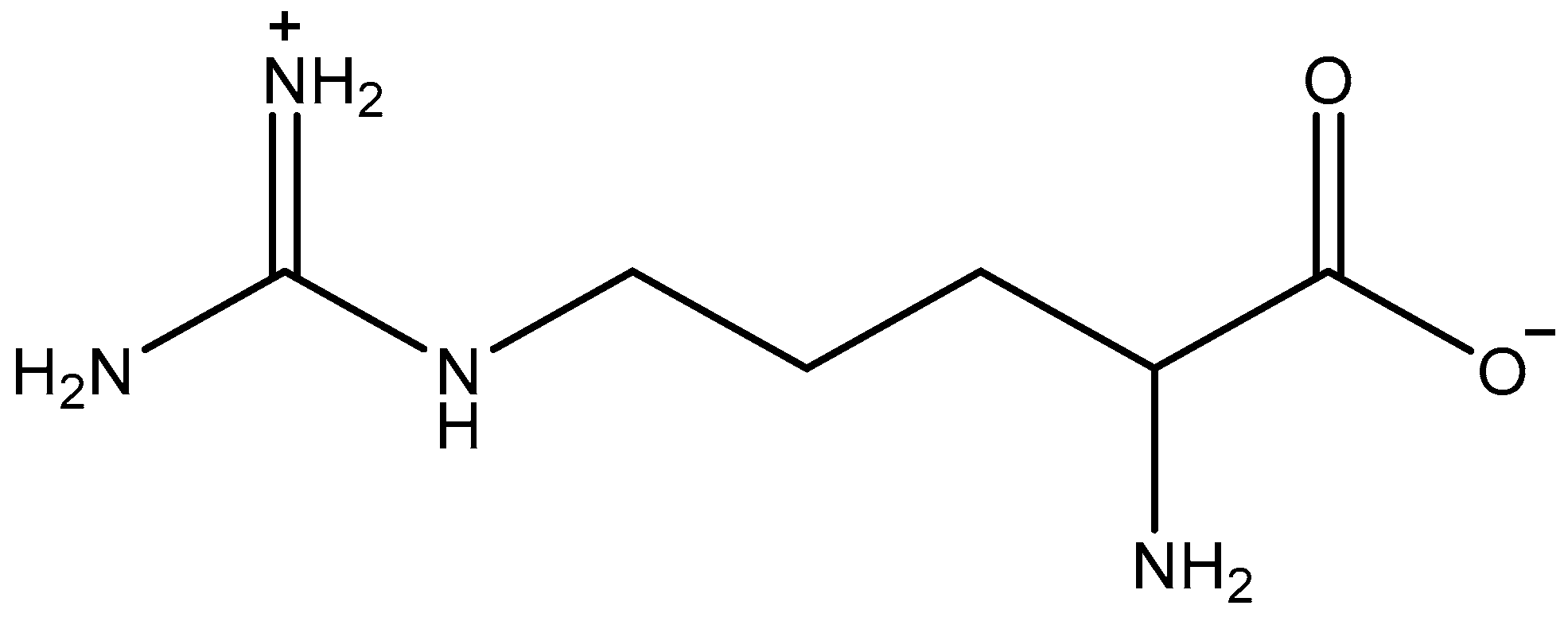

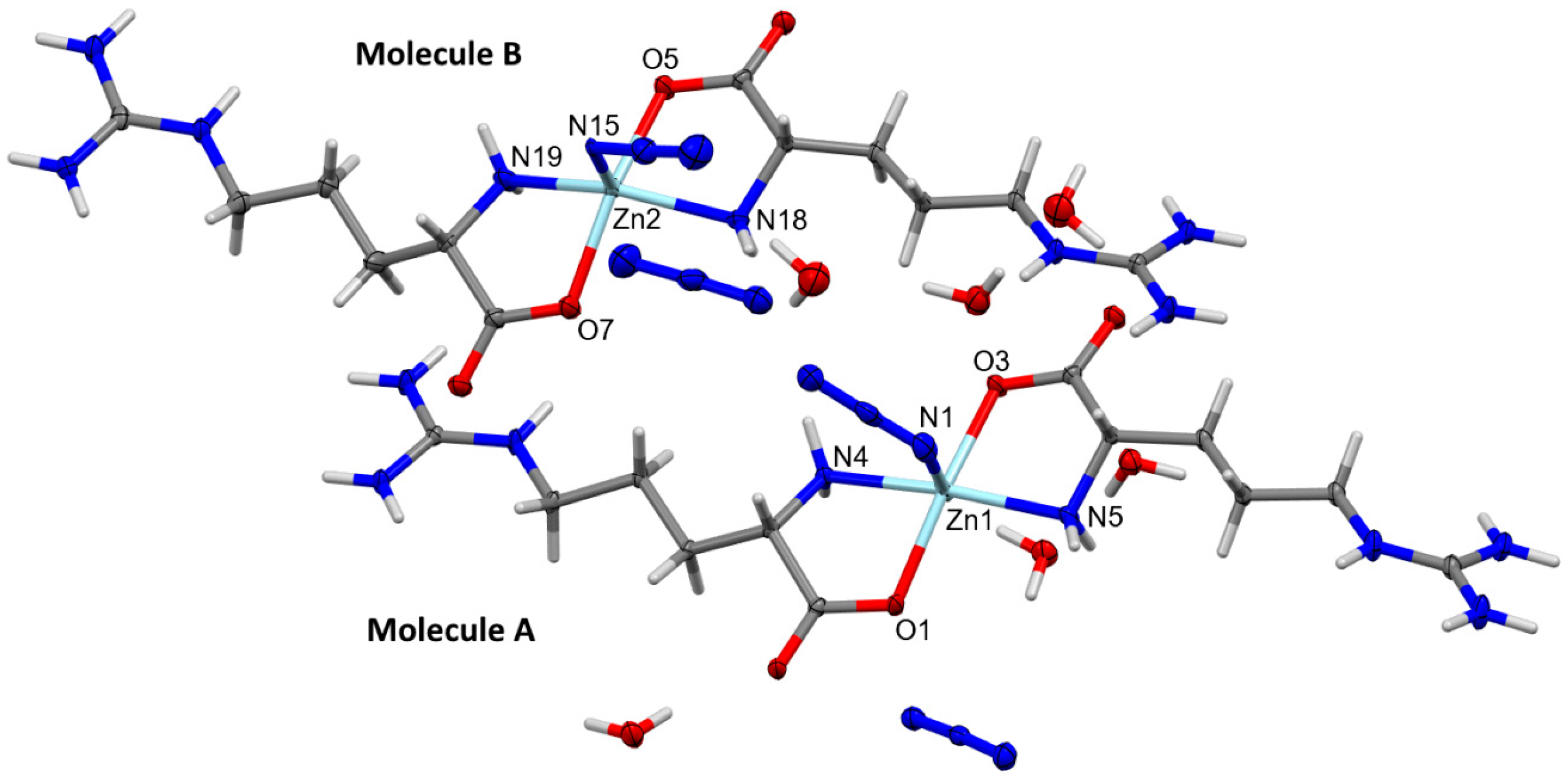
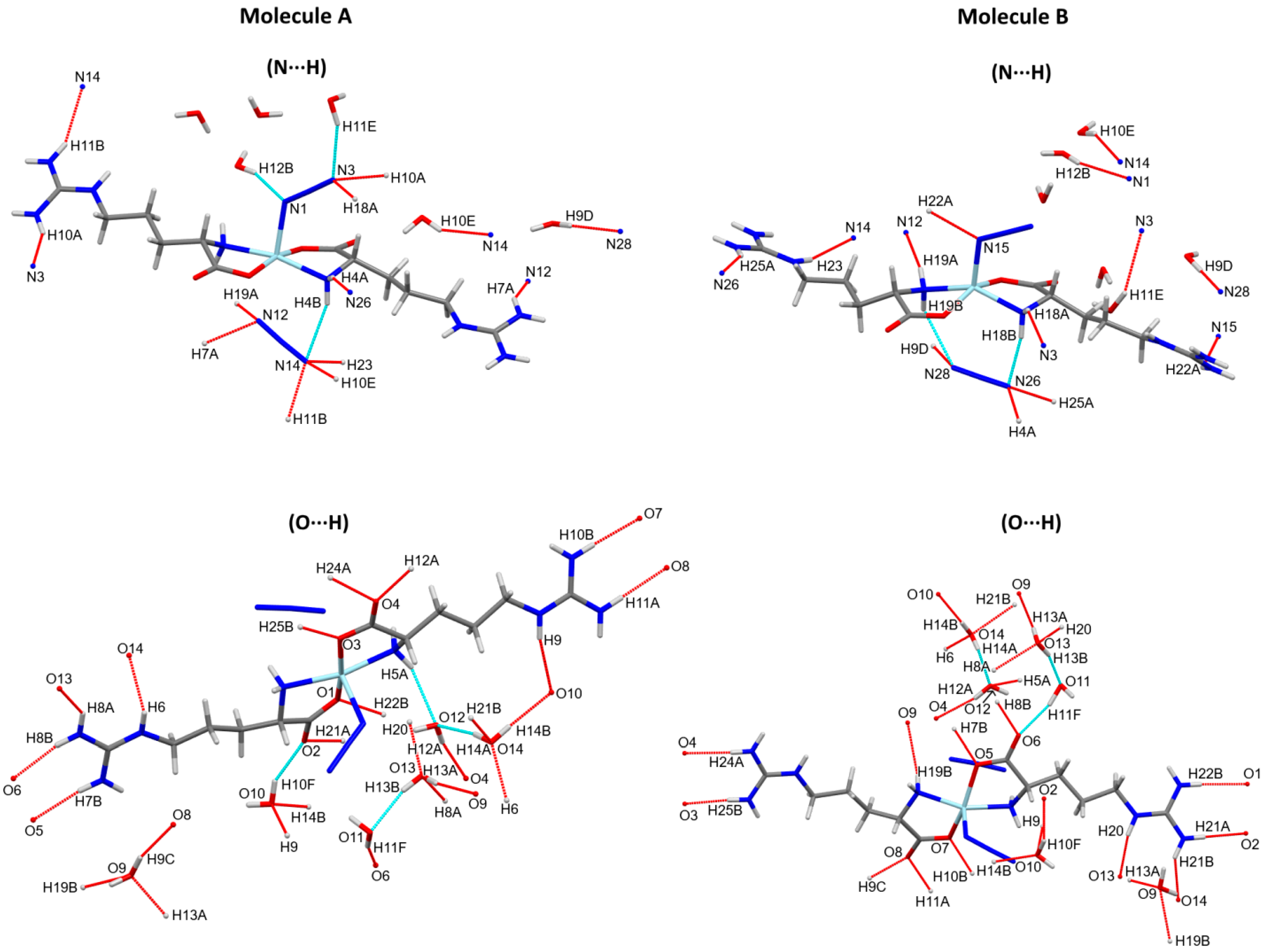
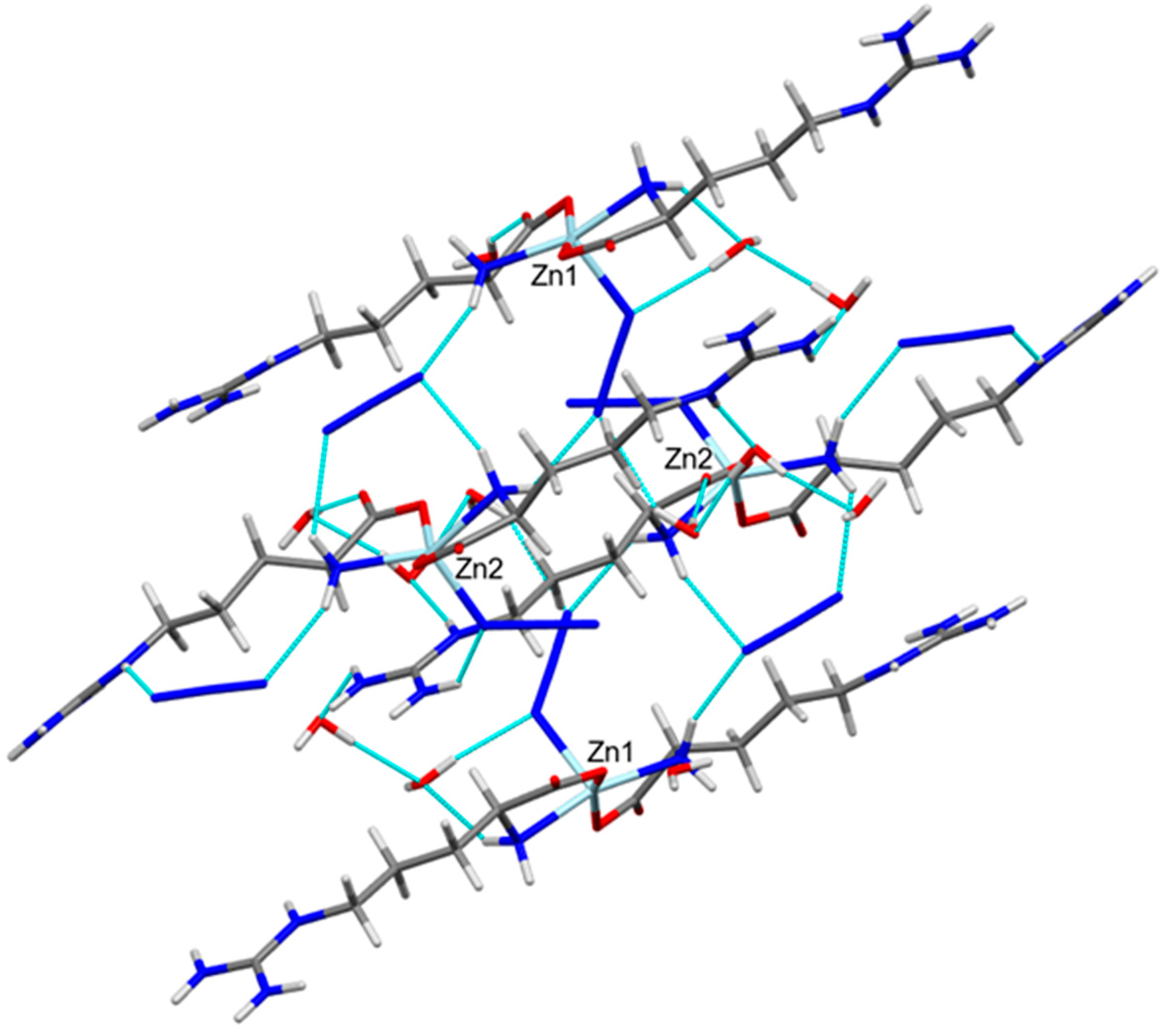
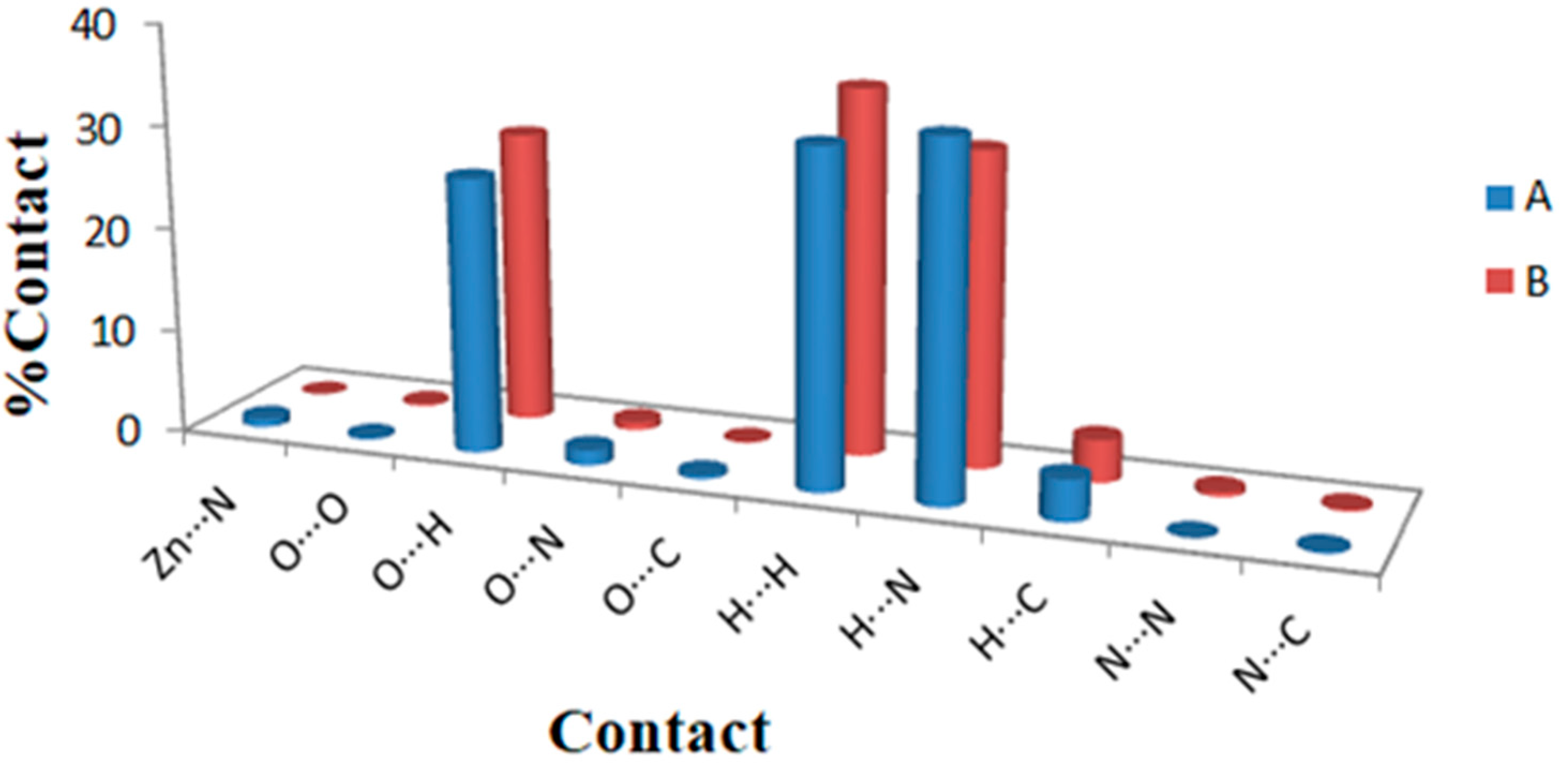
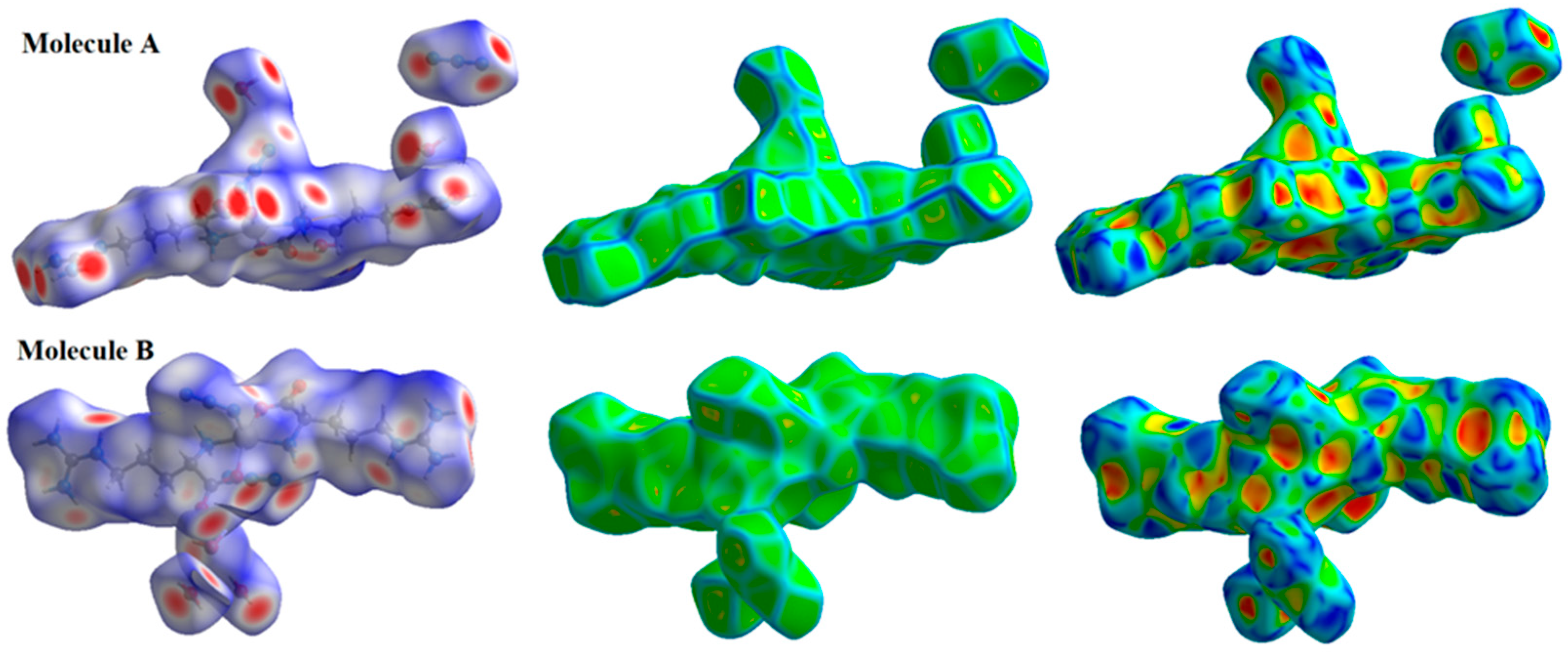
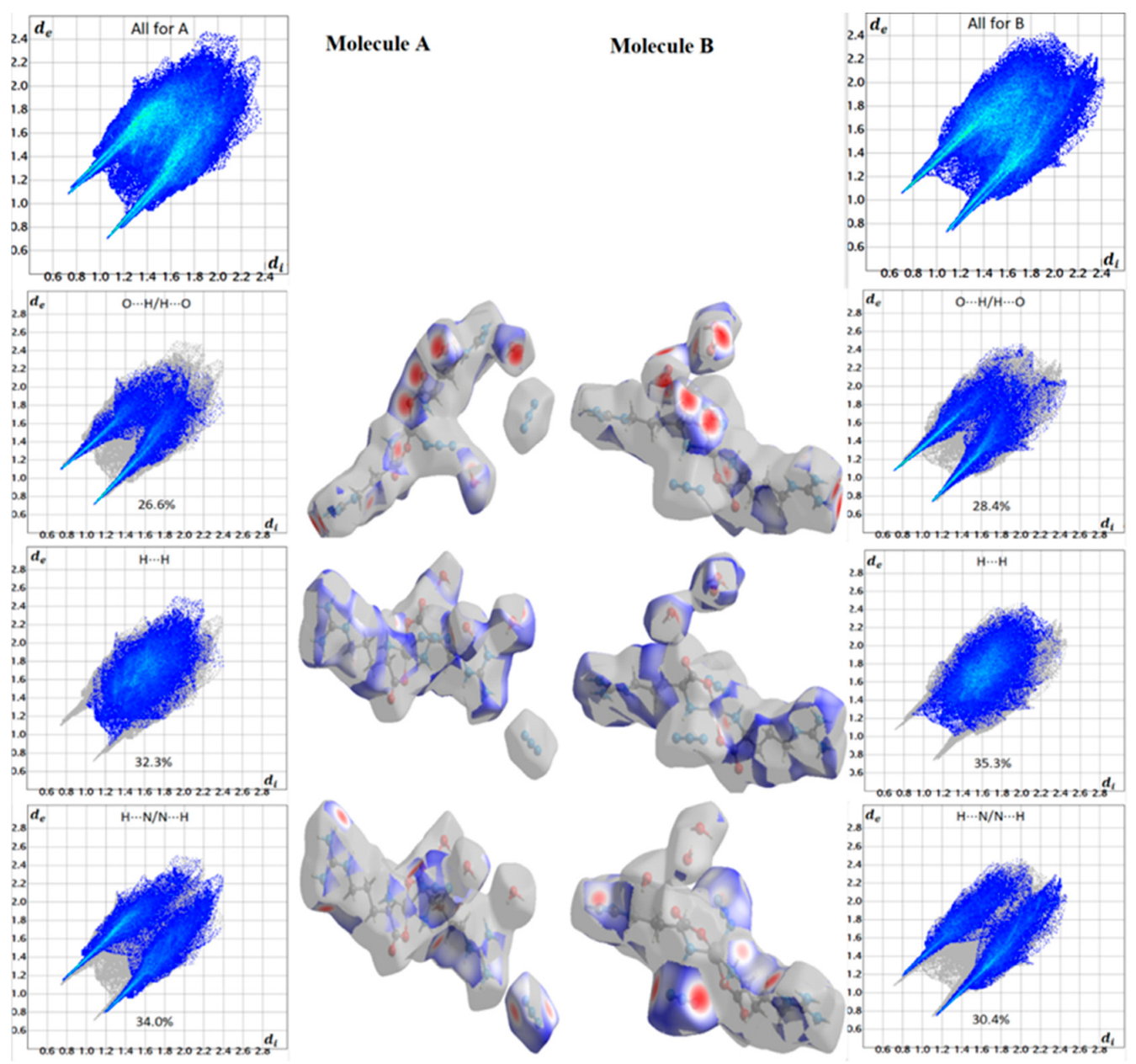
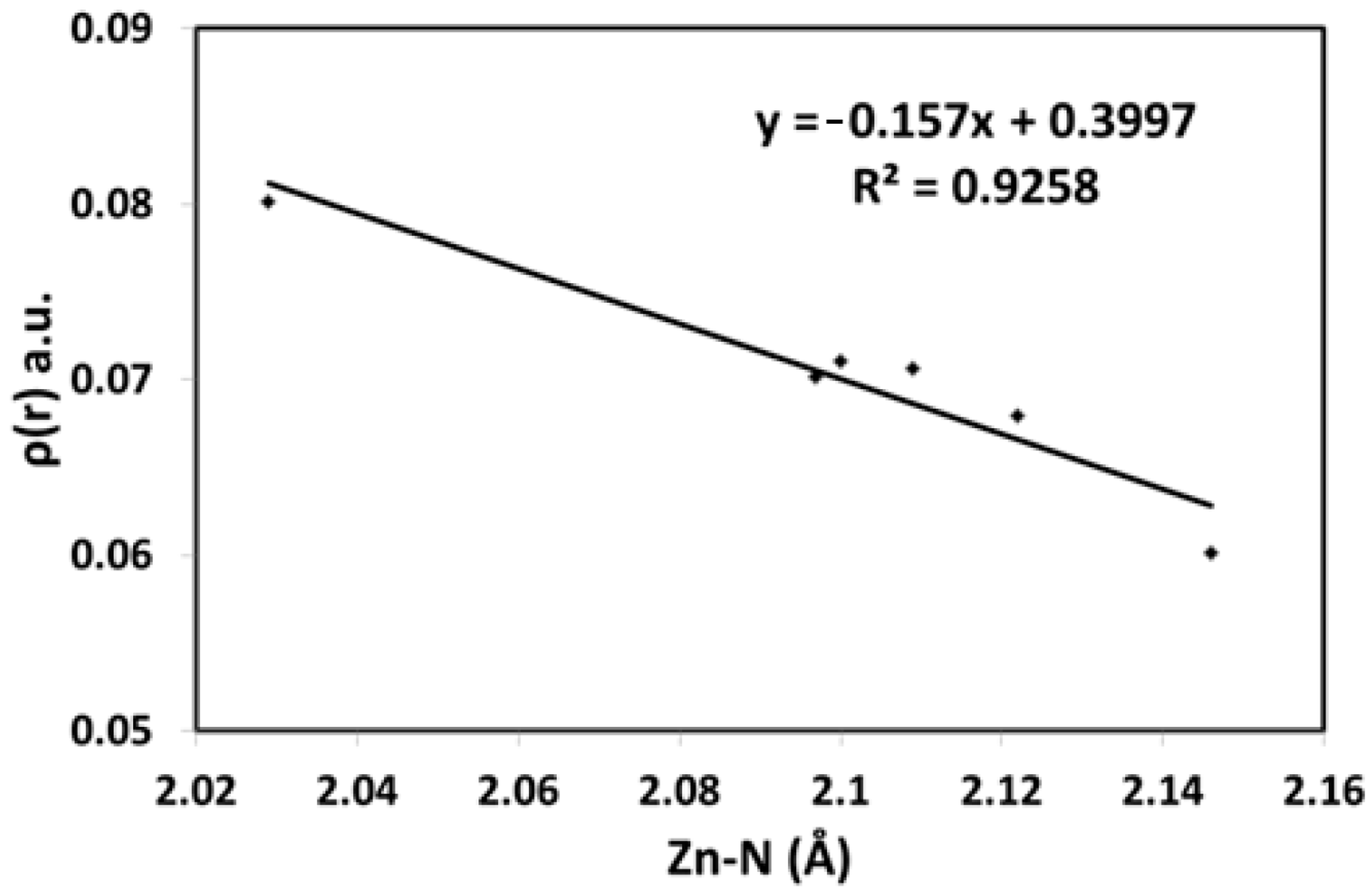
| CCDC | 2290177 |
|---|---|
| Empirical formula | C12H34N14O7Zn |
| Formula weight | 551.90 g/mol |
| Temperature | 100(2) K |
| Wavelength | 0.71073 Å |
| Crystal system | Monoclinic |
| Space group | P21 |
| Unit cell dimensions | a = 13.0283(5) Å |
| b = 15.2032(7) Å | |
| c = 13.3633(6) Å | |
| β = 114.3580(10)° | |
| Volume | 2411.28(18) Å3 |
| Z | 4 |
| Density (calculated) | 1.520 g/cm3 |
| Absorption coefficient | 1.082 mm−1 |
| F(000) | 1160 |
| Crystal size | 0.20 × 0.20 × 0.30 mm3 |
| Radiation | MoKα (λ = 0.71073) |
| 2θ range for data collection | 4.286 to 60° |
| Index ranges | −16 ≤ h ≤ 18, −21 ≤ k ≤ 21, −18 ≤ l ≤ 18 |
| Reflections collected | 41717 |
| Independent reflections | 13927 [R(int) = 0.0371, Rsigma = 0.0425] |
| Data/restraints/parameters | 13927/50/659 |
| Goodness of fit on F2 | 1.051 |
| Final R indices [I > 2sigma(I)] | R1 a = 0.0282, wR2 b = 0.0745 |
| R indices (all data) | R1 a = 0.0313, wR2 b = 0.0756 |
| Flack parameter | 0.026(2) |
| Largest diff. peak and hole | 0.88 and −0.45 e Å−3 |
| Bond | Distance | Bond | Distance |
| Zn1-O3 | 2.058(2) | Zn2-O7 | 2.068(2) |
| Zn1-O1 | 2.078(2) | Zn2-O5 | 2.080 (2) |
| Zn1-N5 | 2.098(2) | Zn2-N19 | 2.100(2) |
| Zn1-N4 | 2.121(2) | Zn2-N18 | 2.111(2) |
| Zn1-N1 | 2.151(2) | Zn2-N15 | 2.019(2) |
| Bond | Angle | Bond | Angle |
|---|---|---|---|
| O3-Zn1-O1 | 166.00(8) | O7-Zn2-O5 | 154.16(11) |
| O3-Zn1-N5 | 80.30(7) | O7-Zn2-N19 | 79.07(7) |
| O1-Zn1-N5 | 98.73(7) | O5-Zn2-N19 | 91.91(7) |
| O3-Zn1-N4 | 98.28(7) | O7-Zn2-N18 | 95.21(8) |
| O1-Zn1-N4 | 79.16(7) | O5-Zn2-N18 | 79.29(7) |
| N5-Zn1-N4 | 165.66(8) | N19-Zn2-N18 | 147.24(11) |
| O3-Zn1-N1 | 100.02(8) | N15-Zn2-O7 | 101.94(9) |
| O1-Zn1-N1 | 93.97(8) | N15-Zn2-O5 | 103.90(9) |
| N5-Zn1-N1 | 92.92(8) | N15-Zn2-N19 | 110.83(9) |
| N4-Zn1-N1 | 101.36(8) | N15-Zn2-N18 | 101.92(8) |
| D-H···A | d(D-H) | d(H···A) | d(D···A) | <(DHA) |
|---|---|---|---|---|
| N4-H4A···N26 #1 | 0.91 | 2.23 | 3.109(4) | 161 |
| N4-H4B···N14 | 0.91 | 2.44 | 3.309(3) | 160 |
| N5-H5A···O12 | 0.91 | 2.28 | 3.080(3) | 146 |
| N6-H6···O14 #2 | 0.88 | 2.14 | 2.855(3) | 138 |
| N7-H7A···N12 #3 | 0.88 | 2.23 | 2.976(3) | 142 |
| N7-H7B···O5 #2 | 0.88 | 1.99 | 2.863(3) | 172 |
| N8-H8A···O13 #2 | 0.88 | 2.22 | 2.933(3) | 138 |
| N8-H8B···O6 #2 | 0.88 | 1.97 | 2.840(3) | 169 |
| N9-H9···O10 #4 | 0.88 | 2.36 | 3.017(3) | 131 |
| O9-H9C···O8 #1 | 0.86(3) | 1.92(3) | 2.752(3) | 164(4) |
| O9-H9D···N28 #2 | 0.86(4) | 1.97(4) | 2.783(5) | 157(4) |
| N10-H10A···N3 #4 | 0.88 | 2.11 | 2.899(3) | 149 |
| N10-H10B···O7 #5 | 0.88 | 1.95 | 2.804(3) | 164 |
| O10-H10E···N14 #3 | 0.82(3) | 2.11(4) | 2.847(3) | 151(3) |
| O10-H10F···O2 | 0.86(3) | 1.98(3) | 2.774(3) | 153(4) |
| N11-H11A···O8 #5 | 0.88 | 1.97 | 2.833(3) | 167 |
| N11-H11B···N14 #6 | 0.88 | 2.27 | 3.059(3) | 149 |
| O11-H11E···N3 | 0.93(2) | 2.48(3) | 3.333(4) | 153(3) |
| O11-H11F···O6 | 0.93(3) | 1.93(3) | 2.835(3) | 163(4) |
| O12-H12A···O4 #7 | 0.84(3) | 1.98(3) | 2.805(3) | 169(4) |
| O12-H12B···N1 | 0.81(3) | 2.15(3) | 2.927(3) | 160(3) |
| O13-H13A···O9 #1 | 0.83(2) | 1.93(2) | 2.750(3) | 169(3) |
| O13-H13B···O11 | 0.84(3) | 1.94(3) | 2.752(4) | 163(3) |
| O14-H14A···O12 | 0.84(2) | 1.96(2) | 2.793(3) | 170(3) |
| O14-H14B···O10 #4 | 0.82(3) | 2.00(3) | 2.820(3) | 178(2) |
| N18-H18A···N3 #8 | 0.91 | 2.44 | 3.206(4) | 142 |
| N18-H18B···N26 | 0.91 | 2.14 | 3.022(3) | 163 |
| N19-H19A···N12 #7 | 0.91 | 2.44 | 3.309(4) | 159 |
| N19-H19B···O9 #6 | 0.91 | 2.39 | 3.199(3) | 149 |
| N19-H19B···N28 | 0.91 | 2.46 | 3.183(5) | 136 |
| N20-H20···O13 #8 | 0.88 | 1.97 | 2.805(3) | 159 |
| N21-H21A···O2 #9 | 0.88 | 1.96 | 2.830(3) | 171 |
| N21-H21B···O14 #8 | 0.88 | 2.28 | 2.921(3) | 130 |
| N22-H22A···N15 #1 | 0.88 | 2.35 | 3.044(3) | 136 |
| N22-H22B···O1 #9 | 0.88 | 2.04 | 2.905(3) | 169 |
| N23-H23···N14 #7 | 0.88 | 2.16 | 2.999(3) | 160 |
| N24-H24A···O4 #10 | 0.88 | 2.06 | 2.893(3) | 158 |
| N25-H25A···N26 #11 | 0.88 | 2.06 | 2.854(3) | 149 |
| N25-H25B···O3 #10 | 0.88 | 1.92 | 2.795(3) | 174 |
| C11-H11C···O6 #4 | 0.99 | 2.54 | 3.502(3) | 163 |
| C16-H16B···N2 #8 | 0.99 | 2.60 | 3.567(3) | 165 |
| C16-H16B···N3 #8 | 0.99 | 2.60 | 3.482(3) | 148 |
| C20-H20A···N22 #8 | 1.00 | 2.57 | 3.517(3) | 158 |
| Contact | Contact Distance | Contact | Contact Distance |
|---|---|---|---|
| O1···H22D | 1.911 | N2···H16A | 2.511 |
| O2···H21C | 1.833 | N3···H18A | 2.368 |
| O3···H25B | 1.792 | N3···H16A | 2.523 |
| O4···H24A | 1.942 | N3···H10C | 1.999 |
| O4···H32 | 1.854 | N12···H11D | 2.157 |
| O5···H7B | 1.859 | N12···H4B | 2.348 |
| O6···H8B | 1.848 | N12···H23 | 2.033 |
| O6···H11A | 2.452 | N14···H7A | 2.129 |
| O7···H10D | 1.825 | N15···H10B | 2.585 |
| O8···H11C | 1.844 | N15···H22C | 2.259 |
| O8···H27 | 1.821 | N16···H10B | 2.544 |
| O9···H19B | 2.300 | N17···H30 | 2.492 |
| O10···H9 | 2.280 | N22···H20 | 2.500 |
| O10···H24B | 2.525 | N26···H25A | 1.954 |
| O13···H8A | 2.129 | N26···H4B | 2.142 |
| O13···H20C | 1.848 | C1···H11B | 2.652 |
| O14···H36 | 2.200 | C24···H3A | 2.506 |
| O14···H6 | 2.044 | Zn1···N14 | 2.701 |
| Bond | ρ(r) | G(r) | V(r) | H(r) | ∇2ρ(r) | |V(r)|/G(r) |
|---|---|---|---|---|---|---|
| Zn1-N1 | 0.0601 | 0.0845 | −0.0955 | −0.0110 | 0.2942 | 1.1302 |
| Zn1-N4 | 0.0679 | 0.0707 | −0.0885 | −0.0178 | 0.2114 | 1.2518 |
| Zn1-N5 | 0.0710 | 0.0763 | −0.0957 | −0.0194 | 0.2278 | 1.2543 |
| Zn1-O1 | 0.0748 | 0.0759 | −0.1002 | −0.0243 | 0.2062 | 1.3202 |
| Zn1-O3 | 0.0785 | 0.0810 | −0.1064 | −0.0253 | 0.2228 | 1.3136 |
| Zn2-N15 | 0.0801 | 0.1241 | −0.1441 | −0.0199 | 0.4166 | 1.1612 |
| Zn2-N19 | 0.0701 | 0.0679 | −0.0852 | −0.0173 | 0.2025 | 1.2548 |
| Zn2-N18 | 0.0706 | 0.0717 | −0.0879 | −0.0163 | 0.2216 | 1.2260 |
| Zn2-O7 | 0.0717 | 0.0747 | −0.0933 | −0.0187 | 0.2240 | 1.2490 |
| Zn2-O5 | 0.0733 | 0.0774 | −0.0970 | −0.0196 | 0.2310 | 1.2532 |
| N1-N2 | 0.5859 | 0.5506 | −1.6496 | −1.0990 | −2.1939 | 2.9962 |
| N2-N3 | 0.4871 | 0.4755 | −1.2591 | −0.7836 | −1.2323 | 2.6479 |
| N15-N16 | 0.4689 | 0.4055 | −1.1231 | −0.7176 | −1.2486 | 2.7698 |
| N16-N17 | 0.5289 | 0.5107 | −1.4142 | −0.9035 | −1.5709 | 2.7689 |
| N12-N13 | 0.5230 | 0.5302 | −1.4503 | −0.9201 | −1.5598 | 2.7355 |
| N13-N14 | 0.5169 | 0.4848 | −1.3841 | −0.8993 | −1.6578 | 2.8549 |
| N26-N27 | 0.5306 | 0.5218 | −1.4392 | −0.9174 | −1.5821 | 2.7579 |
| N27-N28 | 0.5075 | 0.4016 | −1.2082 | −0.8066 | −1.6200 | 3.0084 |
Disclaimer/Publisher’s Note: The statements, opinions and data contained in all publications are solely those of the individual author(s) and contributor(s) and not of MDPI and/or the editor(s). MDPI and/or the editor(s) disclaim responsibility for any injury to people or property resulting from any ideas, methods, instructions or products referred to in the content. |
© 2023 by the authors. Licensee MDPI, Basel, Switzerland. This article is an open access article distributed under the terms and conditions of the Creative Commons Attribution (CC BY) license (https://creativecommons.org/licenses/by/4.0/).
Share and Cite
Altowyan, M.S.; Yousri, A.; Albering, J.H.; Fischer, R.C.; Abu-Youssef, M.A.M.; Ayoup, M.S.; Barakat, A.; Soliman, S.M. A New Zn(II) Azido Complex of L-Arginine: X-ray Crystal Structure, Hirshfeld, and AIM Studies. Crystals 2023, 13, 1375. https://doi.org/10.3390/cryst13091375
Altowyan MS, Yousri A, Albering JH, Fischer RC, Abu-Youssef MAM, Ayoup MS, Barakat A, Soliman SM. A New Zn(II) Azido Complex of L-Arginine: X-ray Crystal Structure, Hirshfeld, and AIM Studies. Crystals. 2023; 13(9):1375. https://doi.org/10.3390/cryst13091375
Chicago/Turabian StyleAltowyan, Mezna Saleh, Amal Yousri, Jörg H. Albering, Roland C. Fischer, Morsy A. M. Abu-Youssef, Mohammed Salah Ayoup, Assem Barakat, and Saied M. Soliman. 2023. "A New Zn(II) Azido Complex of L-Arginine: X-ray Crystal Structure, Hirshfeld, and AIM Studies" Crystals 13, no. 9: 1375. https://doi.org/10.3390/cryst13091375
APA StyleAltowyan, M. S., Yousri, A., Albering, J. H., Fischer, R. C., Abu-Youssef, M. A. M., Ayoup, M. S., Barakat, A., & Soliman, S. M. (2023). A New Zn(II) Azido Complex of L-Arginine: X-ray Crystal Structure, Hirshfeld, and AIM Studies. Crystals, 13(9), 1375. https://doi.org/10.3390/cryst13091375










